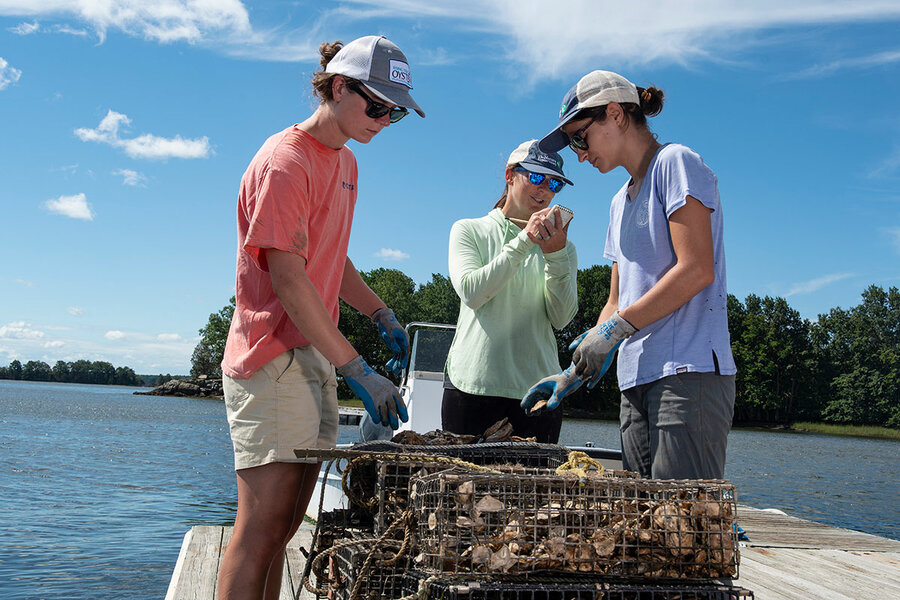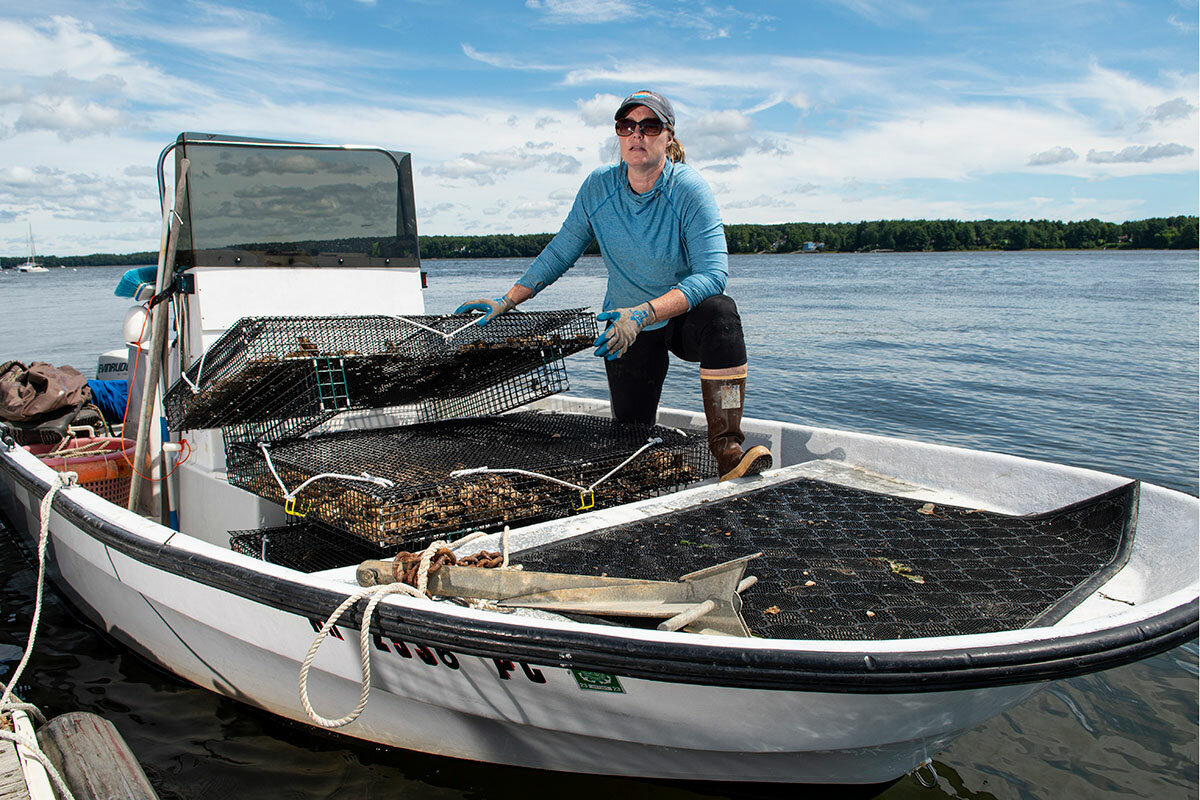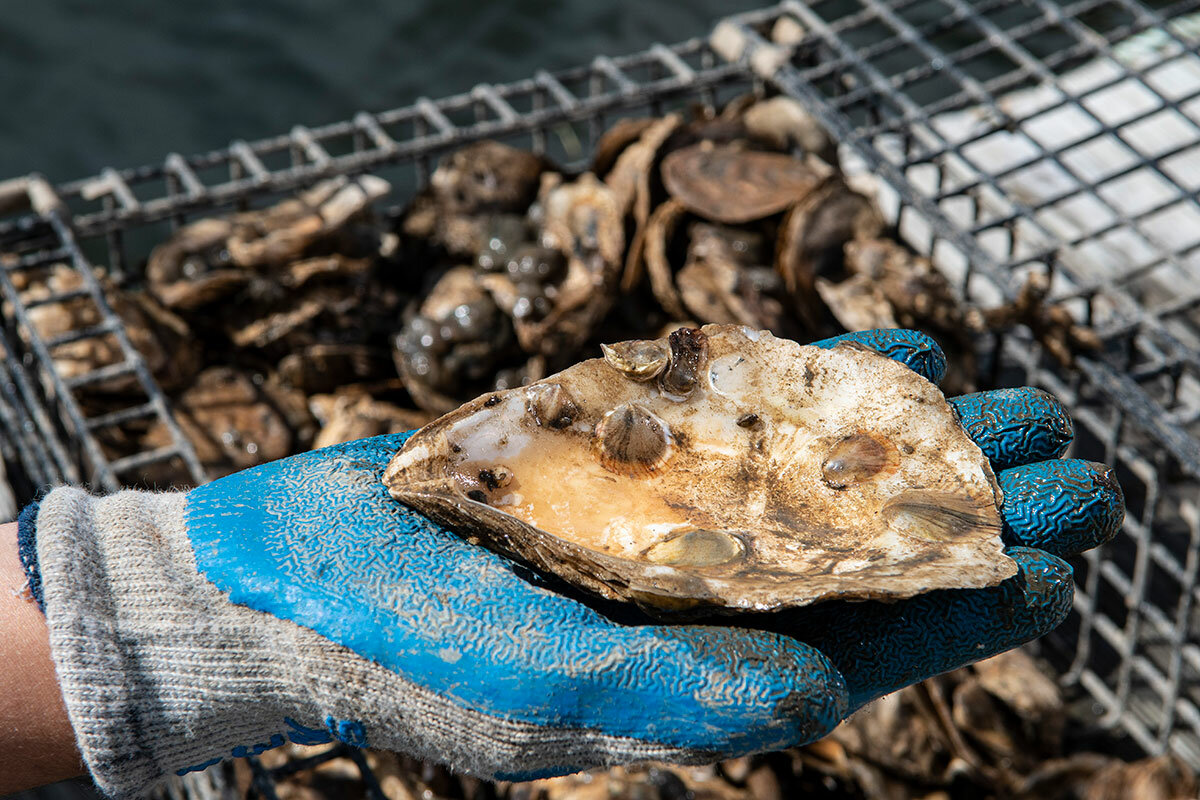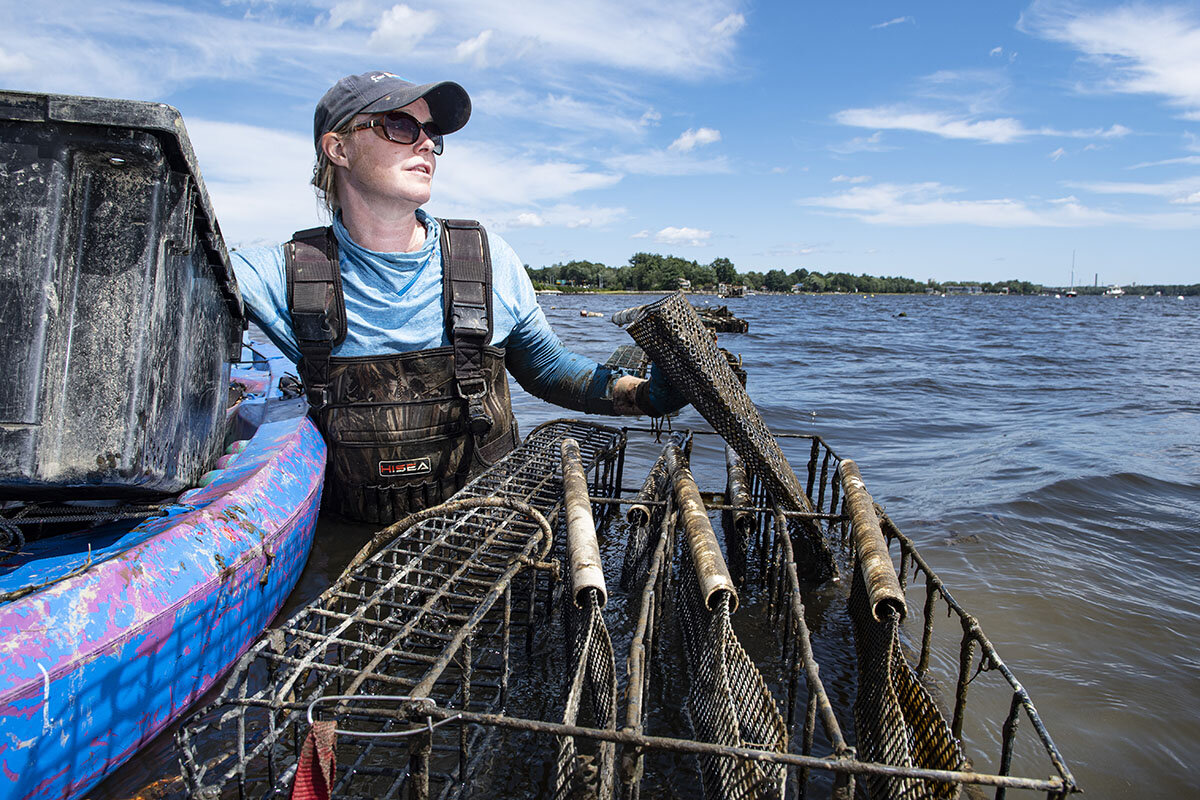Helping bays become ‘a better spot’ for oysters – and farmers
Loading...
| Great Bay, N.H.
The sun sparkles on the surface of Great Bay, the silt suspended in the murky water from the previous day’s rainfall. But from her spot on the dock, Brianna Group doesn’t notice. Head tilted down, hands in rubber work gloves, she meticulously counts baby oysters. She and her team of conservationists don’t have a moment to waste. The oyster farmers are coming.
“This one has seven,” says Ms. Group, a program manager for The Nature Conservancy in Great Bay, a tidal estuary close to New Hampshire’s coastal border with Maine. She holds up a shell with baby oysters, known as “spat,” attached and rapidly fills dozens of giant, flat mesh cages. The baby oysters were grown in water tanks steps away at the University of New Hampshire’s estuarine laboratory.
Suddenly, as if on cue, a skiff approaches the dock, carrying sisters Laura Brown and Krysten Ward, arriving to transport the baby oysters to their nearby aquaculture farms. “If we make space, I think we can take all of them in one trip. We need to get these in the water,” Ms. Brown says.
Why We Wrote This
A story focused onA partnership between conservationists and oyster farmers is expanding after a promising start. The project helps rebuild wild oyster reefs and provides reliable income to farmers.
These oysters are not for eating. Instead, they are part of a partnership that brings aquaculture farmers and conservationists together to help boost dwindling oyster populations and provide farmers with a dependable income. The collaboration has proven successful enough that The Nature Conservancy and its partners have dedicated $6.3 million in additional funding to further scale the program over the next four years.
“It’s the perfect partnership,” says Ms. Brown, who is a former artist turned owner of Fox Point Oysters, a small aquaculture farm located in the waters of Great Bay. “The Nature Conservancy getting involved in oyster restoration and partnering with us for that just makes the whole bay a better spot,” with cleaner water and a better habitat for oysters, she says.
Replenishing a lost population
New England’s coastal waters were once filled with oyster reefs. Yet after centuries of overfishing, pollution, and disease, the number of reefs has trended closer and closer to zero.
Native oysters in Great Bay were decimated from more than 25 million in 1993 to around 1.2 million in 2000, a 95% loss. Like coral reefs in warmer waters, oyster reefs – clustered together by the hundreds or even thousands – are the foundation of coastal food chains. They protect shorelines, provide shelter for marine life, and are natural water filters. A single adult oyster can filter up to 50 gallons of water a day.
“We’re down below 10% of the oyster resource on the wild reefs of what we were beginning in about the late 1990s,” says Ray Grizzle, a research professor at the University of New Hampshire.
When the pandemic closed restaurants and oyster bars in 2020, oyster farmers across the country found their livelihoods threatened. That’s when conservationists from The Nature Conservancy, an environmental nonprofit based in Virginia, launched the Supporting Oyster Aquaculture and Restoration project (SOAR), in partnership with The Pew Charitable Trusts, the U.S. Department of Agriculture, and the U.S. National Oceanic and Atmospheric Administration. The program purchases oysters from farmers in seven states, including New Hampshire, to use in restoration projects.
Three years later, the program is notching early successes in the Granite State, with growth in the juvenile oyster population in Great Bay.
For the last 20 years, The Nature Conservancy and the University of New Hampshire have grown oysters in a lab and deployed the small, baby ones onto artificial reefs. But using adult oysters from farms is a “new twist,” says Professor Grizzle. “It’s an unusual arrangement and unusual collaboration for us and I think pretty much for everybody in the oyster restoration business.”
So far, results suggest that the older, larger adult oysters from farms are more adept at filtering water, resisting predators, and producing more larvae to further grow reefs.
Repurposing the “big uglies”
On the tailgate of Ms. Brown’s black pickup, her business slogan reads, “From the bay to your belly!” When pandemic lockdowns clammed up her restaurant clientele, Ms. Brown began selling her oysters from her flatbed truck near her farm in Little Bay, New Hampshire.
Then The Nature Conservancy offered her a partnership. They would buy her large adult oysters and hire Ms. Brown to raise their lab-grown oysters at her subtidal farm.
“We already grow them out here, and we’re more successful at it,” Ms. Brown says. “So they give them to us, and we raise them or we give them some of the big uglies, and then we can restore some of the natural reefs they’re working on.” The “big uglies,” an affectionate industry term for oversize oysters, are typically rejected by restaurants.
In the first phase of the SOAR project, more than two dozen oyster farmers in New Hampshire and Maine earned extra income and more than 666,000 farmed oysters were deployed onto artificial reefs, placed adjacent to wild reefs to help them repopulate.
This year, the New Hampshire Fish and Game Department counted more juvenile oysters near two Nature Conservancy restoration sites than any other sampled locations in Great Bay. The number of baby oysters observed near Nannie Island in Great Bay was at the highest level since 2006.
Due to the initial success of the program in New Hampshire and other states, the organizers of SOAR are expanding the number of participating sites and of oysters purchased. The next phase is to expand into new restoration sites in New Hampshire, Maine, Massachusetts, New York, New Jersey, Maryland, California, and Washington state.
“We really are developing this concept into a replicable model,” says Steve Kirk, director of The Nature Conservancy’s Massachusetts Coastal Program. While the specifics will vary by state – Massachusetts has different regulations for coastal management, for instance – one thing is certain for Mr. Kirk and others leading the expansion.
“Building these partnerships in the community helps us all out,” he says. “We’re all in this for the long haul.”








